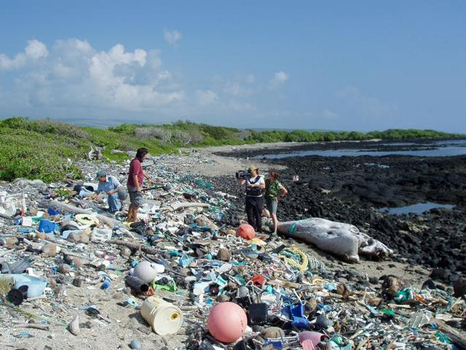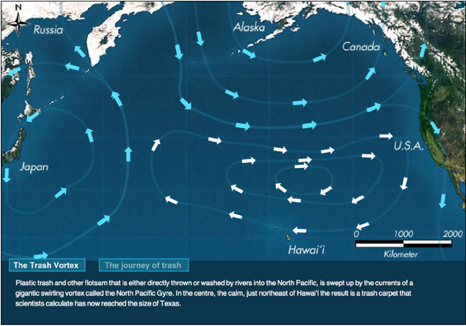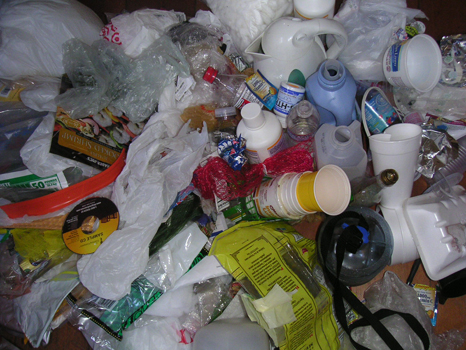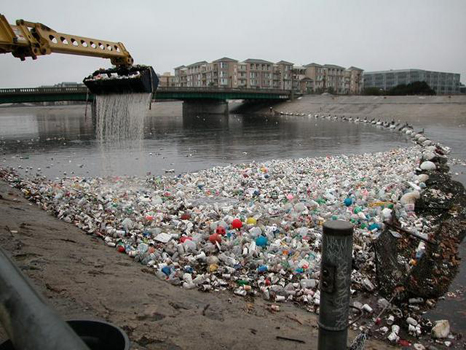
Global warming is not the only threat that marine organisms face. In the North-East Pacific a vortex of plastic rubbish is taking over the ocean, swamping marine ecosystems and ultimately posing a danger to human life. Known formally as the Great Pacific Garbage Patch or the Eastern Garbage Patch, the phenomena arises because circulating currents of the sub-tropical gyre naturally tend to agglomerate floating materials in this region. Historically, floating debris was broken down by microorganisms, but now a new class of materials has upset this balance – in a word, plastic. Unlike naturally occurring compounds, plastic does not photo-degrade, it simply breaks up into ever-smaller pieces and lingers in the environment as an invisible toxic dust.

Plastic trash on Kamilo Beach Feb 8 2006 - photo by the Algalita Marine Research Foundation
For the past half century plastic has been accumulating in the central Pacific gyre. Research by Charles Moore of the Algalita Foundation has documented that there is now 6 pounds of plastic for every pound of phytoplankton across an area that is already twice the size of Texas and growing every day. Around the world 100 million tones of plastic are produced each year and according to Greenpeace 10% of it ends up in the sea. A study by the United Nations Environmental Program estimates that in this region there are 46,000 floating pieces of plastic for every square mile of ocean and the trash now circulates to a depth of 30 meters. In the Fall of 2006 the Greenpeace vessel Esperanza made a voyage to measure the amount of debris, which exceeded even the grimmest expectations.
When the central cell of the gyre drifts over the Hawaiian Islands, Waimanalo Beach on Oahu is coated with blue-green plastic sand while Midway Atoll – a major rookery for albatross – is now a permanent trash heap. Greenpeace estimates that a million sea birds a year die from plastic ingestion, many of them chicks that have starved to death with bellies full of plastic cigarette lighters, toy soldiers and bottle caps. 100,000 marine mammals also die. Sea turtles migrating past the Garbage Patch do not know the difference between a floating jellyfish and a floating plastic bag and routinely chow down on the later, as do laysan and black footed albatross. Moore has photographed transparent filter feeding creatures, their innards laced with brightly colored plastic fragments.
And there is a darker side. Tiny fragments of plastic act as sponges for persistent organic pollutants such as DDT and PCB’s, oily toxins that don’t dissolve in water. Plastic pellets in the region have been found to accumulate up to one million times the level of these poisons – and they are entering the food chain from the filter feeders up. One day it is we who will be ingesting these toxins.
One of the most insidious forms of plastic pollution is nurdles, small pellets that serve as the feedstock for all those nifty disposable items that fill the supermarket shelves. Nurdles are manufactured in central plastic plants then shipped around the world to factories where they are colored and melted and poured into molds. 250 billion pounds of nurdles are shipped each year and vast numbers of them are spilled during transfer in and out of railroad cars. [Algalita Foundation] Much of this spillage ends up in gutters and drains and eventually makes its way to the ocean. One tenth of beach trash worldwide is nurdles and they have been found as far afield as Antarctica. When the Esperanza visited the Rubbish Vortex, every single trawl netted nurdles. To albatross, nurdles look a lot like clumps of roe and they are often mistaken for food and fed to infant birds.
Scientists who study the problem say there is no solution except to cut down on our use of plastic. Now. Of the 15 billion pounds of plastic the US produces each year just 1 billion is recycled. [Greenpeace] Though many plastics can be recycled in principle, in practice sorting it into separate categories is too labor intensive to be viable. Moreover, many complex products like cell phones and computers have so many different plastic components that sorting out the various types would be prohibitively expensive. Since the 1950’s plastic usage has increased tenfold every decade so that in 2001 the average American used 223 pounds of plastic. By the end of the decade it is estimated that our average yearly use will be 326 pounds. [Los Angeles Times] Every hour Americans use and discard 2.5 million plastic bottles, totaling 22 billion a year.

At the IFF we have taken up the challenge to cut down our personal plastic quotient. Since the start of 2007 we have been keeping all our plastic waste. After 2 days we were appalled. After a week we were horrified. After a month we were devastated. No matter how much we try not to, it just keeps accumulating. We are planning to keep an entire year’s worth of plastic as a record. It is a truly sobering experience. We encourage everyone to do this exercise as a lesson for themselves - there is nothing like living with a heap of your own PVC and Styrofoam to make you think twice about what you bring home from the supermarket. Hint #1: get some canvas Eco-bags – they may look naff but they are way cooler than the huge pile of plastic shopping bags accumulating in the corner of the kitchen. [In Australia many stores now charge 5 cents for every plastic bag and that charge will soon be required by law.]
Scientists who study the Rubbish Vortex say there is little we can do to clean it up so that even if we stopped using plastic tomorrow its residue will remain for thousands of years. Most of what is there now will eventually sink to the ocean floor where it will seriously disrupt benthic ecosystems. In the future, the twentieth century will be clearly visible in the geologic record by an indelible layer of plastic, as if a vast rain of synthetic meteorites had crashed to the earth. All we can do is to stop producing more of the stuff. We cannot quit the habit overnight, but slowly we must wean ourselves off this invidiously convenient drug.

As the satanic sibling of the Crochet Coral Reef, the IFF is also crocheting a Rubbish Vortex from discarded plastic bags and a colorful selection of plastic trash. The Queen of the Rubbish Vortex is our Australian contributor Helle Jorgensen. If the Crochet Reef provides our aesthetic pleasure, it is the Rubbish Vortex that serves as our moral guide.

An attempt being made to collect some of the plastic that is found in the LA River as it heads to the Pacific Ocean.